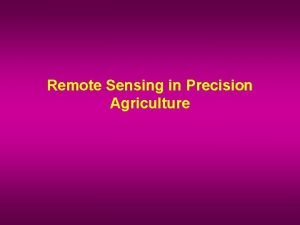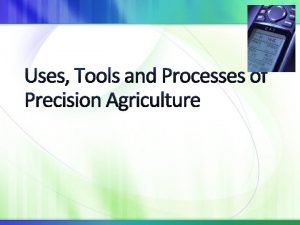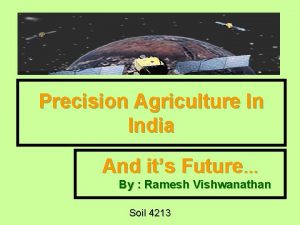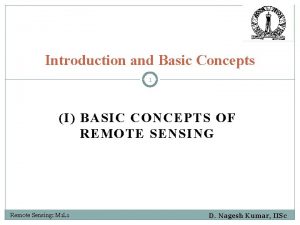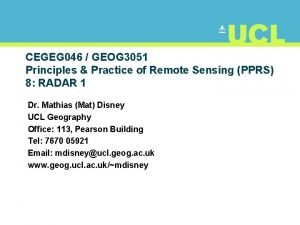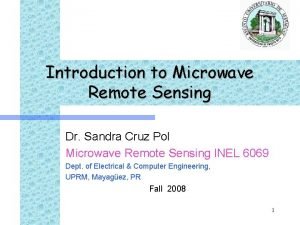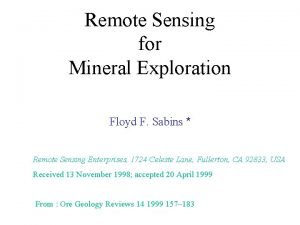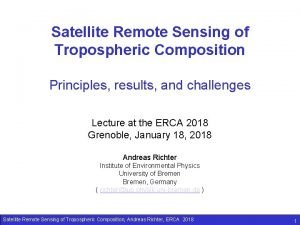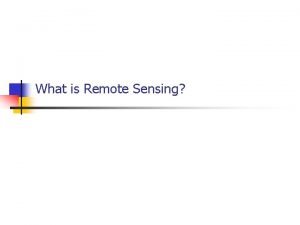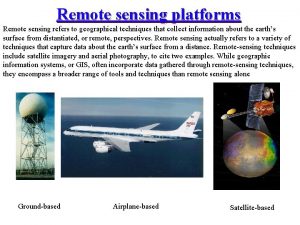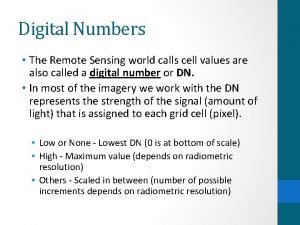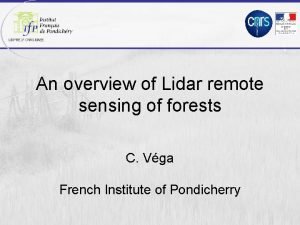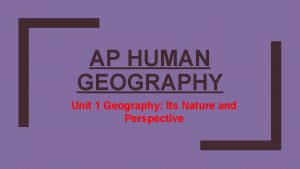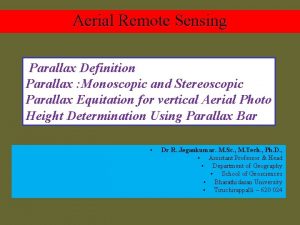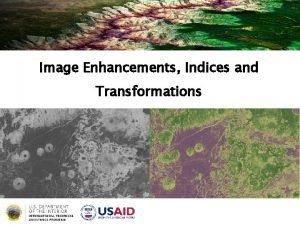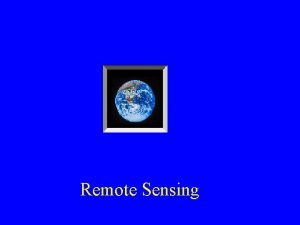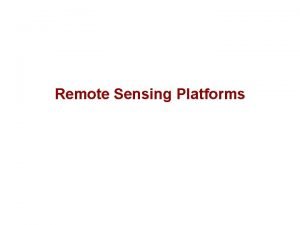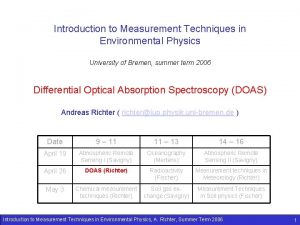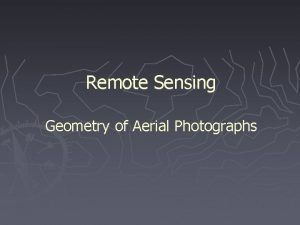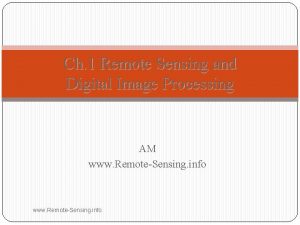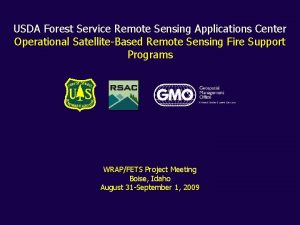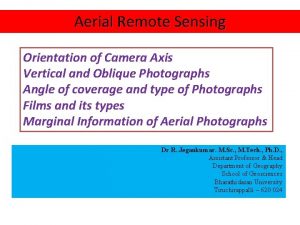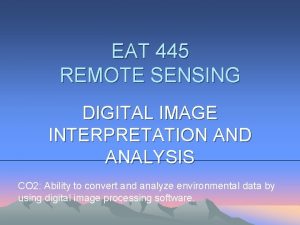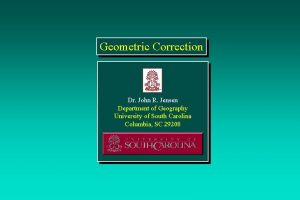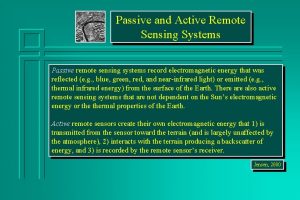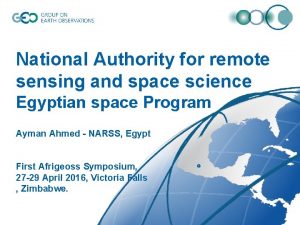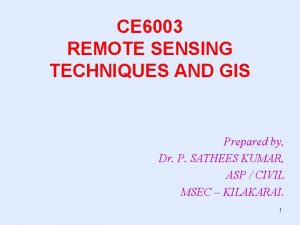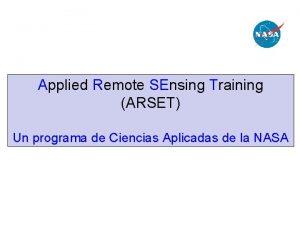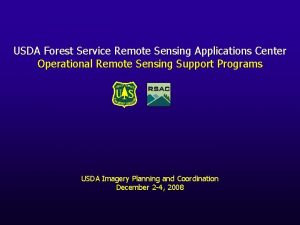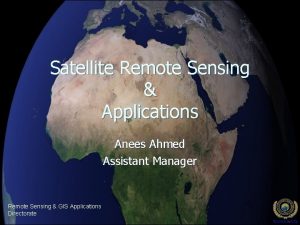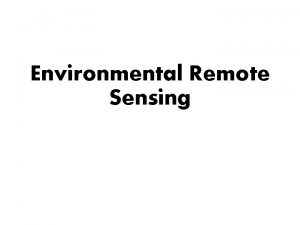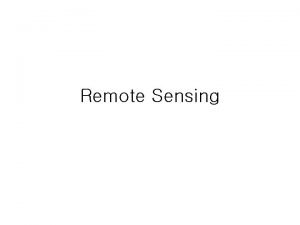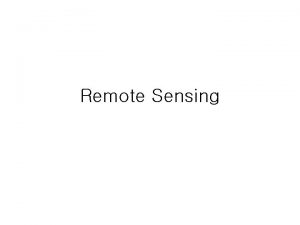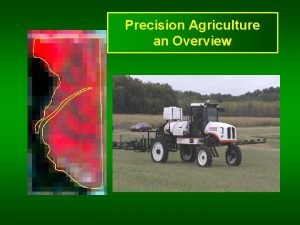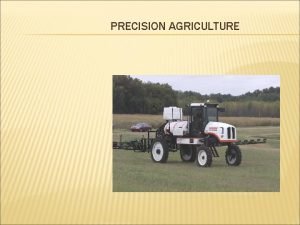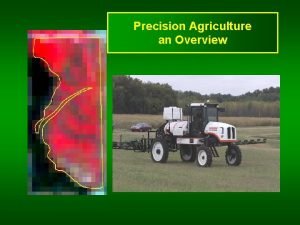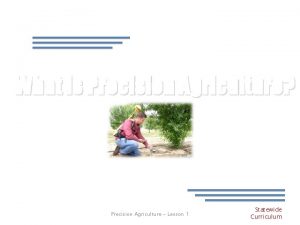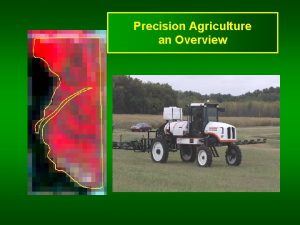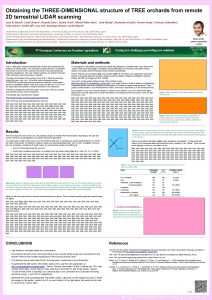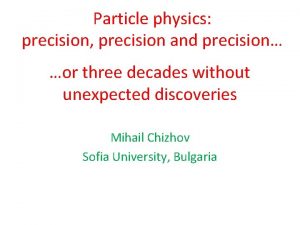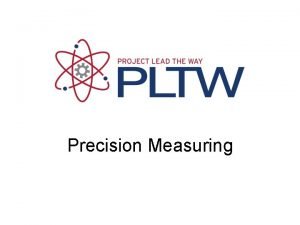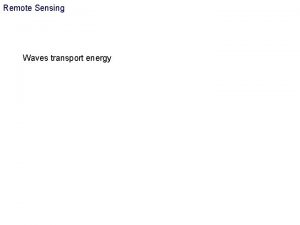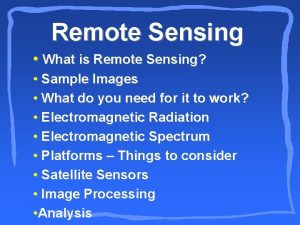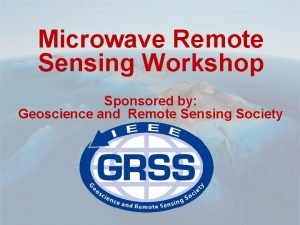Remote Sensing in Precision Agriculture Remote Sensing The





















































- Slides: 53

Remote Sensing in Precision Agriculture

Remote Sensing • The science and art of obtaining information about an object, area, or phenomenon through the analysis of data acquired by a device that is not in contact with object, area, or phenomenon under investigation.

Four Divisions of Remote Sensing • Remote Sensing can divide into four stages or division based on altitude of the sensor. – Ground Observation - approximately 0 50 ft. – Low Altitude Airplane - <10, 000 ft – High Altitude Airplane - > 10, 000 ft – Satellite > 150 miles

Advantages of Ground Level Sensors • Lowest per unit cost • With a self-contained light source, have complete control over incident light, which simplifies calibration and correction. • Ability to collect data at any time. • Potential for very high resolution data collection.

• Data can be easily georeferenced for use in a GIS.

Disadvantages of Ground Level Sensing • Relatively high costs to scan large areas unless part of another field operation. • Cannot simultaneously scan entire fields.

Turf Scanned with OSU Sensor 700. 00 0. 70 600. 00 0. 65 0. 60 500. 00 0. 55 0. 50 0. 45 400. 00 0. 40 0. 35 300. 00 0. 30 0. 25 200. 00 0. 20 0. 15 100. 00 200. 00 300. 00 400. 00

Possible Configuration of a Sensor/Applicator

OSU/Patchen Active Lighted Sensor with GPS Mounted on an ATV

40 ac of Wheat Pasture Center Scanned with ATV

Interpolated Surface from ATV Scanned Data

Noble Foundation - Pepsi Field OSU/Patchen ATV Sensor Scan

Noble Foundation Pepsi Field NDVI Classified Fixed Interval Scale with Kriging

Noble Foundation Pepsi Field NDVI – Natural Breaks Classification

Advantages of Aerial Remote Sensing • Can quickly scan large area. • Cost/ac when scanning large areas is relatively low. • Data can be collected at high resolution < 1 m. • User has some control over when data are collected.

Disadvantages of Aerial Remote Sensing • Images must be rectified and georeferenced. • Cost to scan small areas is high. • Data can’t be collected at night or in bad weather. • Radiometric calibration must be performed on the images for temporal comparisons.

Methods of Optical Sensing • Photographic • Digital Imaging

NDVI of OSU Experiment Station 1 m Resolution

Detail of Southwest Corner

False Color Image Noble Foundation Red River Ranch Illustrating Slope Aspect and Bi -directional Reflectance

Corn at Shelton, NE NDVI - Late Sept. 1997

3/25/98 Wheat Pasture Center 1 -m Resolution NDVI Image

4/23/98 Wheat Pasture Center 1 -m Resolution NDVI Image

False Color (green, red, NIR) Image < 1 m Resolution - Raw Radiometric Data (Courtesy F. Schiebe, SST Development Group)

False Color (green, red, NIR) Image < 1 m Resolution – Reflectance Corrected Radiometric Data (Courtesy F. Schiebe SST Dev. )

Gray Scale Image < 1 m Resolution – Reflectance Corrected NDVI (Courtesy F. Schiebe, SST Dev. Grp. )

Reflectance Corrected Gray Scale Image < 1 m Resolution – Green to Near Infrafed Ratio (Courtesy F. Schiebe, SST Dev. Grp. )


Advantage of Satellite Sensing • Historical data are readily available. • Cost/ac of large area images is vary low. • Very large areas can be scanned nearly instantaneously. • Data for radiometric bands up to 16 micro meters are available.

Disadvantages of Satellite Sensing • Resolution is lower than other sources. • Cannot control when an area is scanned, e. g. each area is scanned every 16 to 26 days. • Correction of radiometric data is challenging because of atmospheric interference.

Remote Sensing System Measures of Performance • • Spatial Resolution Spectral Response Spectral Resolution Frequency of Coverage

Landsat Satellite Program • United States NASA satellites • Images from Landsat 5 and 7 are available from Space Imaging Corporation www. spaceimaging. com (formerly EOSAT • Images from Landsat 7 available from USGS, Sioux Falls, South Dakota

Landsat Satellites • • Landsat Scene - 185 km x 185 km TM quantatization Range 256 (8 bits) 16 day repeat cycle per satellite Currently one satellite is operational • Satellite crosses the equator at 9: 45 local time (North to South Pass)

Sensor Used on Current Landsat Satellites

Landsat Thematic Mapper (TM) Landsat 5

TM Spectral Bands

Landsat TM Bands

Landsat TM Bands

TM Image North Central Oklahoma April, 1998

April 23, 1998 TM Scene over North Central Oklahoma

Systeme Pour l’Observation de la Terre (SPOT) • Orbit repeats every 26 days • 60 km wide field-of-view per camera or 117 km field of view with both units • Quantatization Range 256 (8 bits) • Images available through www. spot. com

Systeme Pour l’Observation de la Terre (SPOT)

SPOT XS image

SPOT Pan image

Indian Research Satellite IRS - LISS 3 Satellites • • • 23 m Resolution 4 bands 5 m Resolution - Panchromatic 142 by 145 km Image Size 24 day repeat cycle Images available through Spaceimaging at www. spaceimaging. com

IRS-LISS

IKONIS • Resolution – 4 m multispectral – 1 m Panchromatic • Scene size is approximately 7 miles by 7 miles • Scenes are available from Space Imaging • Farm size images marketed by Earthscan Network, a subsidiary of DTN

IKONOS

Ball Aerospace –Quick. Bird 2 Scene Size Approximated 16. 5 by 16. 5 km Bands: Panchromatic – 70 cm resolution B&W 450 -900 nm Multispectral – 2. 8 m resolution Blue Green Red NIR 450 -520 nm 520 -600 nm 630 -690 nm 760 -900 nm 8 or 16 Bits per Pixel Positional Accuracy 23 m 90% CE 14 m RMSE

Quick. Bird Example From Digital Globe http: //www. digitalglobe. com/

Steps to Utilize Remote Sensed Data (modified from JD text • Collect data • Process image data (rectification, radiometric correction, and georeferencing) • Examine image and analyze statistical data • Perform ground truthing of remotesensed data

Steps to Utilize Remote Sensed Data (modified from JD text • Incorporate remote sensed and ground truth data into a GIS • Develop calibration equations for remote sensed data • Identify cause-effect relationships among measured variables and crop conditions • Treat regions in fields (management zones) based on information generated

Marshall Wheat Pasture Center Calibration Data
 Remote sensing in precision agriculture
Remote sensing in precision agriculture Bcd gösterimi
Bcd gösterimi Example of a non-precision measuring instrument
Example of a non-precision measuring instrument Semi precision attachments
Semi precision attachments Precision agriculture in the philippines
Precision agriculture in the philippines Precision farming definition
Precision farming definition Precision agriculture in india
Precision agriculture in india Limitations of remote sensing
Limitations of remote sensing Remote sensing
Remote sensing Introduction to microwave remote sensing
Introduction to microwave remote sensing Canada centre for remote sensing
Canada centre for remote sensing Remote sensing aphg
Remote sensing aphg Graduated symbol map definition ap human geography
Graduated symbol map definition ap human geography Advantages of remote sensing
Advantages of remote sensing Remote sensing physics
Remote sensing physics Energy transfer
Energy transfer Ifov and fov in remote sensing
Ifov and fov in remote sensing Digital number in remote sensing
Digital number in remote sensing Full waveform lidar
Full waveform lidar Distortion ap human geography
Distortion ap human geography What is stereoscopic parallax
What is stereoscopic parallax Remote sensing
Remote sensing Microwave remote sensing lecture notes
Microwave remote sensing lecture notes Remote sensing platforms
Remote sensing platforms Remote sensing physics
Remote sensing physics Geometry of aerial photography
Geometry of aerial photography Limitations of remote sensing
Limitations of remote sensing Supervised classification
Supervised classification Remote sensing applications center
Remote sensing applications center Strip camera in remote sensing
Strip camera in remote sensing Digital interpretation in remote sensing
Digital interpretation in remote sensing Geometric corrections
Geometric corrections Aerial photography in remote sensing pdf
Aerial photography in remote sensing pdf Active vs passive remote sensing
Active vs passive remote sensing National authority for remote sensing and space sciences
National authority for remote sensing and space sciences Idealized remote sensing system
Idealized remote sensing system Applied remote sensing training program
Applied remote sensing training program Remote sensing applications center
Remote sensing applications center Remote sensing image
Remote sensing image Khi nào hổ mẹ dạy hổ con săn mồi
Khi nào hổ mẹ dạy hổ con săn mồi Công thức tiính động năng
Công thức tiính động năng Thiếu nhi thế giới liên hoan
Thiếu nhi thế giới liên hoan Hát kết hợp bộ gõ cơ thể
Hát kết hợp bộ gõ cơ thể điện thế nghỉ
điện thế nghỉ Nguyên nhân của sự mỏi cơ sinh 8
Nguyên nhân của sự mỏi cơ sinh 8 độ dài liên kết
độ dài liên kết Các môn thể thao bắt đầu bằng tiếng nhảy
Các môn thể thao bắt đầu bằng tiếng nhảy Số.nguyên tố
Số.nguyên tố Gấu đi như thế nào
Gấu đi như thế nào Tia chieu sa te
Tia chieu sa te Một số thể thơ truyền thống
Một số thể thơ truyền thống Sơ đồ cơ thể người
Sơ đồ cơ thể người Trời xanh đây là của chúng ta thể thơ
Trời xanh đây là của chúng ta thể thơ
